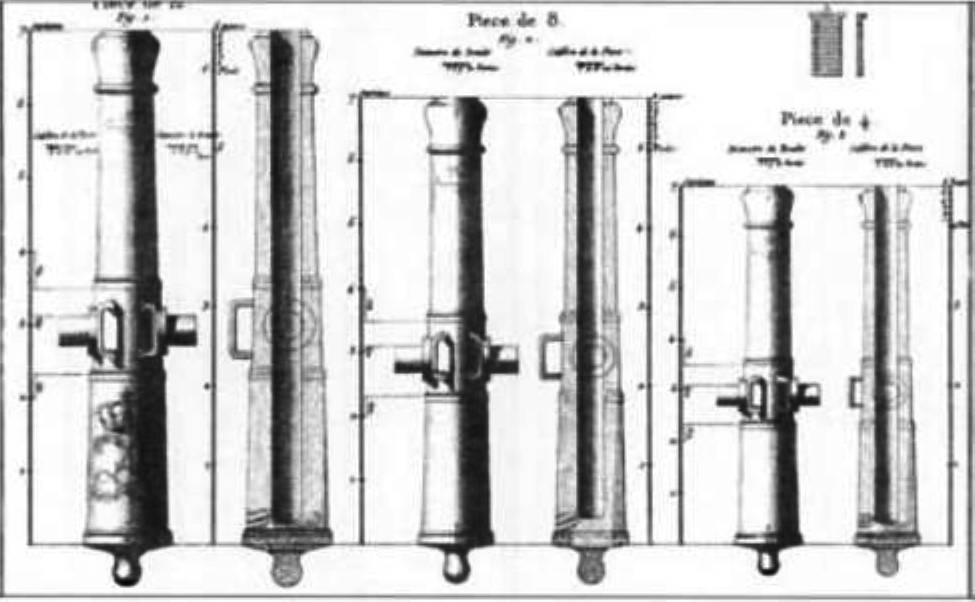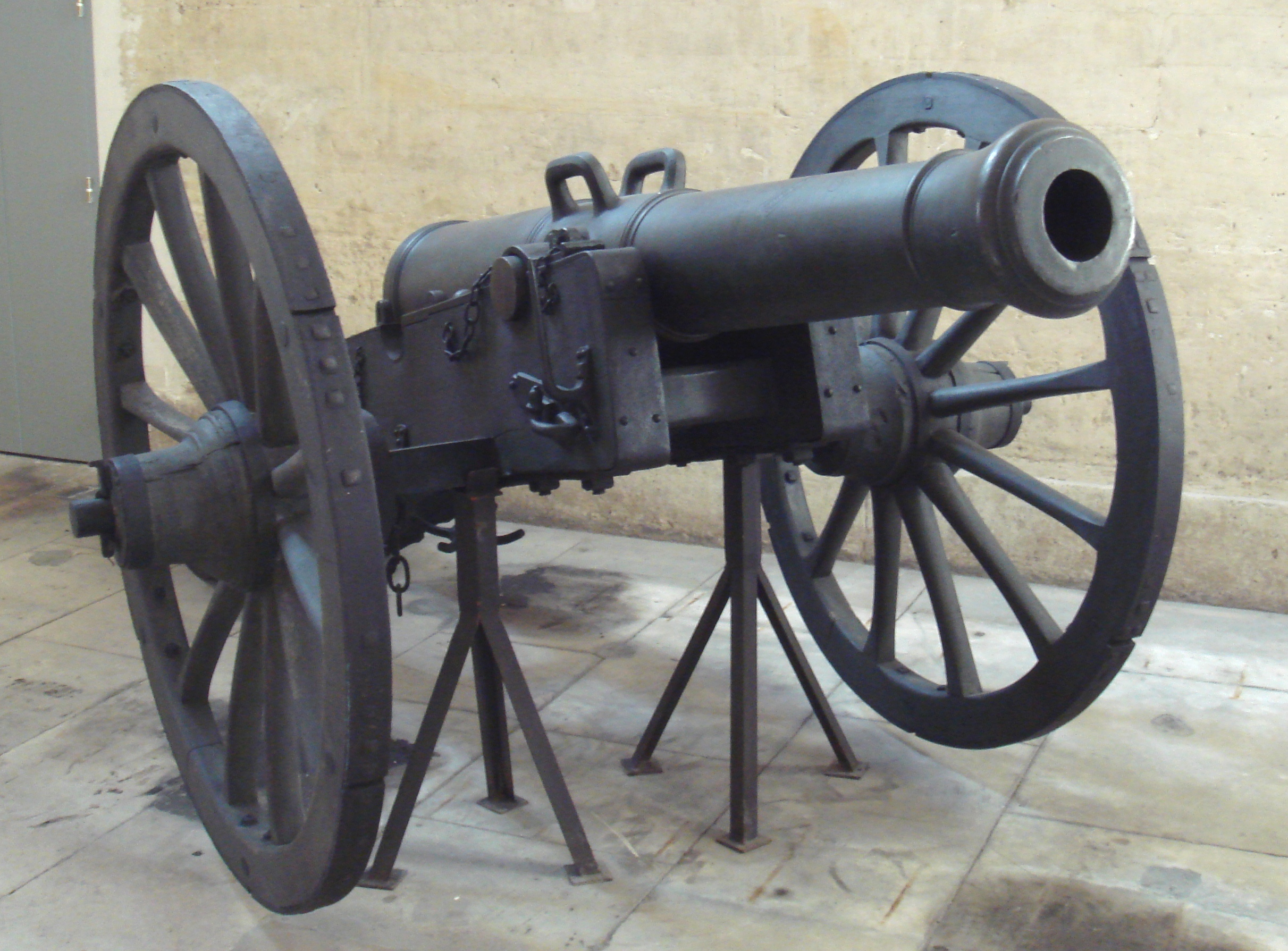Gribeauval on:
[Wikipedia]
[Google]
[Amazon]

 Subsequently, he was for some years in disfavour at court. However, he became first inspector of artillery in 1776, in which year also he received the grand cross of the St Louis Order. He was now able to carry out the reforms in the artillery arm which are his chief title to fame. The ''Table des constructions des principaux attirails de l'artillerie ... de M. de Gribeauval'' covers all the French artillery equipment in detail. He was also responsible for the ''règlement'' for the French artillery issued in 1776. Although much of the work is not directly attributable to Gribeauval, these systems of organisation and uniformity in ordnance have been called ''le système Gribeauval''.
Subsequently, he was for some years in disfavour at court. However, he became first inspector of artillery in 1776, in which year also he received the grand cross of the St Louis Order. He was now able to carry out the reforms in the artillery arm which are his chief title to fame. The ''Table des constructions des principaux attirails de l'artillerie ... de M. de Gribeauval'' covers all the French artillery equipment in detail. He was also responsible for the ''règlement'' for the French artillery issued in 1776. Although much of the work is not directly attributable to Gribeauval, these systems of organisation and uniformity in ordnance have been called ''le système Gribeauval''.
Lieutenant General
Lieutenant general (Lt Gen, LTG and similar) is a military rank used in many countries. The rank traces its origins to the Middle Ages, where the title of lieutenant general was held by the second-in-command on the battlefield, who was norma ...
Jean-Baptiste Vaquette de Gribeauval (; 15 September 1715 – 9 May 1789) was a French artillery
Artillery consists of ranged weapons that launch Ammunition, munitions far beyond the range and power of infantry firearms. Early artillery development focused on the ability to breach defensive walls and fortifications during sieges, and l ...
officer
An officer is a person who has a position of authority in a hierarchical organization. The term derives from Old French ''oficier'' "officer, official" (early 14c., Modern French ''officier''), from Medieval Latin ''officiarius'' "an officer," fro ...
and engineer who revolutionised the French cannon
A cannon is a large-caliber gun classified as a type of artillery, which usually launches a projectile using explosive chemical propellant. Gunpowder ("black powder") was the primary propellant before the invention of smokeless powder during th ...
, creating a new production system that allowed for lighter, more uniform guns without sacrificing range.
His Gribeauval system superseded the de Vallière system. These guns proved essential to French military victories during the Napoleonic Wars
{{Infobox military conflict
, conflict = Napoleonic Wars
, partof = the French Revolutionary and Napoleonic Wars
, image = Napoleonic Wars (revision).jpg
, caption = Left to right, top to bottom:Battl ...
. Gribeauval is credited as the earliest known advocate for the interchangeability of gun parts. He is thus one of the principal influences on the later development (over many decades by many people) of interchangeable manufacture.
Early life
Jean-Baptiste was born inAmiens
Amiens (English: or ; ; , or ) is a city and Communes of France, commune in northern France, located north of Paris and south-west of Lille. It is the capital of the Somme (department), Somme Departments of France, department in the region ...
, the son of a magistrate. He entered the French royal artillery in 1732 as a volunteer, and became an officer in 1735. For nearly twenty years regimental duty and scientific work occupied him, and in 1752 he became captain of a company of miners
A miner is a person who extracts ore, coal, chalk, clay, or other minerals from the earth through mining. There are two senses in which the term is used. In its narrowest sense, a miner is someone who works at the rock face (mining), face; cutt ...
.Summerfield (2011) ''SOJ-2'', p. 20 In 1755, he was employed in a military mission in Prussia
Prussia (; ; Old Prussian: ''Prūsija'') was a Germans, German state centred on the North European Plain that originated from the 1525 secularization of the Prussia (region), Prussian part of the State of the Teutonic Order. For centuries, ...
.
In 1757, being then a lieutenant colonel, he was lent to the Austria
Austria, formally the Republic of Austria, is a landlocked country in Central Europe, lying in the Eastern Alps. It is a federation of nine Federal states of Austria, states, of which the capital Vienna is the List of largest cities in Aust ...
n army on the outbreak of the Seven Years' War
The Seven Years' War, 1756 to 1763, was a Great Power conflict fought primarily in Europe, with significant subsidiary campaigns in North America and South Asia. The protagonists were Kingdom of Great Britain, Great Britain and Kingdom of Prus ...
, and established the Austrian sapper
A sapper, also called a combat engineer, is a combatant or soldier who performs a variety of military engineering duties, such as breaching fortifications, demolitions, bridge-building, laying or clearing minefields, preparing field defenses ...
corps. He led the sapping operations at the Siege of Glatz and the defence of Schweidnitz. At Schweidnitz, his 1748 design of fortification gun was tested and significantly improved by Master Carpenter Richter.
In 1762, he reported back to the Paris authorities on the Austrian artillery system compared with the existing French de Vallière guns. While with the Austrian army he also worked on the continued development of mining in siegecraft.
The empress Maria Theresa
Maria Theresa (Maria Theresia Walburga Amalia Christina; 13 May 1717 – 29 November 1780) was the ruler of the Habsburg monarchy from 1740 until her death in 1780, and the only woman to hold the position suo jure, in her own right. She was the ...
rewarded him for his work with the rank of ''Feldmarschallleutnant'' and the Grand Cross of the Military Order of Maria Theresa
The Military Order of Maria Theresa (; ; ; ; ; ) was the highest military honour of the Habsburg monarchy, Austrian Empire and Austro-Hungarian Empire.
History
Founded on 18 June 1757, the day of the Battle of Kolín, by the Empress Mari ...
. On his return to France he was made ''maréchal de camp
''Maréchal de camp'' (sometimes incorrectly translated as field marshal) was a general officer rank used by the French Army until 1848.
The rank originated from the older rank of sergeant major general ( French: ''sergent-major général'') ...
'' (major general), in 1764 Inspector of artillery, and in 1765 ''lieutenant général
Lieutenant general (Lt Gen, LTG and similar) is a military rank used in many countries. The rank traces its origins to the Middle Ages, where the title of lieutenant general was held by the second-in-command on the battlefield, who was normall ...
'' and commander of the Order of Saint Louis
The Royal and Military Order of Saint Louis () is a dynastic order of chivalry founded 5 April 1693 by King Louis XIV, named after Saint Louis (King Louis IX of France). It was intended as a reward for exceptional officers, notable as the fi ...
.Summerfield (2011) ''SOJ-2'', p. 14
Gribeauval system

 Subsequently, he was for some years in disfavour at court. However, he became first inspector of artillery in 1776, in which year also he received the grand cross of the St Louis Order. He was now able to carry out the reforms in the artillery arm which are his chief title to fame. The ''Table des constructions des principaux attirails de l'artillerie ... de M. de Gribeauval'' covers all the French artillery equipment in detail. He was also responsible for the ''règlement'' for the French artillery issued in 1776. Although much of the work is not directly attributable to Gribeauval, these systems of organisation and uniformity in ordnance have been called ''le système Gribeauval''.
Subsequently, he was for some years in disfavour at court. However, he became first inspector of artillery in 1776, in which year also he received the grand cross of the St Louis Order. He was now able to carry out the reforms in the artillery arm which are his chief title to fame. The ''Table des constructions des principaux attirails de l'artillerie ... de M. de Gribeauval'' covers all the French artillery equipment in detail. He was also responsible for the ''règlement'' for the French artillery issued in 1776. Although much of the work is not directly attributable to Gribeauval, these systems of organisation and uniformity in ordnance have been called ''le système Gribeauval''.
References
Sources
* Chartrand, René (2003), ''Napoleon's guns 1792–1815 (2)'', Osprey Publishing, * Chevalier de Passac, ''Précis sur M. de Gribeauval'' (Paris, 1816) * Dawson, A. L., Dawson P. L. and Summerfield S. (2007) ''Napoleonic Artillery'', Crowood Press, * Graves, Donald (2011) "Louis de Tousard and his 'Artillerists Companion': An Investigation of Source Material for Napoleonic Period Ordnance", ''Smoothbore Ordnance Journal'', pp. 88–97, * Hennbert, ''Gribeauval, lieutenant-général des armées du roy'' (Paris, 1896) * * Puységur in ''Journal de Paris
The (1777–1840) was the first daily French newspaper.(7 October 2014)The first French daily: Journal de Paris History of JournalismAndrews, ElizabethBetween Auteurs and Abonnés: Reading the Journal de Paris, 1787–1789 ''Journal of the Weste ...
'', supplement of 8 July 1789
* Smith, Digby (trans.) (2011) "The 18 Questions on Austrian Artillery that Gribeauval Answered in his report Dated March 1762", ''Smoothbore Ordnance Journal'', Issue 1, pp. 60–65,
* Smith, Digby (trans.) (2011) "Biography of Jean Baptiste de Gribeauval (1715–1789) in Wurzbach 1859", ''Smoothbore Ordnance Journal'', Issue 1, pp. 58–64,
* Summerfield, Stephen (2011) "Summary of Gribeauval's Life", ''Smoothbore Ordnance Journal'', Issue 2, pp. 9–23,
* Summerfield, Stephen (2011) "Gribeauval in Austrian Service", ''Smoothbore Ordnance Journal'', Issue 2, pp. 24–35,
* Summerfield, Stephen (2011) "Gribeauval Garrison Carriage", ''Smoothbore Ordnance Journal'', Issue 2, pp. 36–56,
* Summerfield, Stephen (2011) "Gribeauval's Objection towards Regimental Artillery", ''Smoothbore Ordnance Journal'', Issue 2, pp. 57–59,
* Veyrines, (1889) ''Gribeauval'' Paris
* Wurzbach, Constant von (1859) ''Biographisches Lexikon des Kaiserthums Oesterreich,'' Volume 5, pp. 332–334
*
{{DEFAULTSORT:Gribeauval, Jean-Baptiste Vaquette De
French generals
French military engineers
1715 births
1789 deaths
Grand Crosses of the Military Order of Maria Theresa
Commanders of the Order of Saint Louis